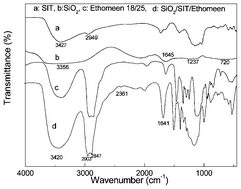The preparation of a silica nanoparticle hybrid ionic nanomaterial and its electrical properties
Abstract
The

* Corresponding authors
a
School of Materials Science and Engineering, Jiangsu University of Science and Technology, Zhenjiang 212003, China
E-mail:
myzjx@yahoo.cn
b
Department of Applied Chemistry, School of Natural and Applied Science, Northwestern Polytechnical University, Xi'an 710072, China
E-mail:
zhengyp@nwpu.edu.cn
c Publication Quality Supervision and Inspection of GAPP-ShaanXi Branch Center, Xi'an 710018, China
d Shenzhen Capchem Technology Co., LTD, Shenzhen 518118, China
The

 Please wait while we load your content...
Something went wrong. Try again?
Please wait while we load your content...
Something went wrong. Try again?
J. Zhang, Y. Zheng, L. Lan, Q. Shi, M. Wu, S. Lu and C. Yan, RSC Adv., 2013, 3, 16714 DOI: 10.1039/C3RA42053A
To request permission to reproduce material from this article, please go to the Copyright Clearance Center request page.
If you are an author contributing to an RSC publication, you do not need to request permission provided correct acknowledgement is given.
If you are the author of this article, you do not need to request permission to reproduce figures and diagrams provided correct acknowledgement is given. If you want to reproduce the whole article in a third-party publication (excluding your thesis/dissertation for which permission is not required) please go to the Copyright Clearance Center request page.
Read more about how to correctly acknowledge RSC content.
 Fetching data from CrossRef.
Fetching data from CrossRef.
This may take some time to load.
Loading related content
